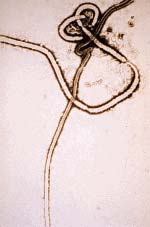![]() In a list of the most dangerous jobs in the world, ‘Ebola researcher’ must surely rank near the top. But if new research is anything to go by, it may soon fall several places. An international team of scientists have recently found a way to neuter the virus, making it easy to study without risking your life. The altered virus looks like Ebola and behaves like Ebola, but it can’t kill like Ebola. It should make studying the virus easier and most importantly, safer.
In a list of the most dangerous jobs in the world, ‘Ebola researcher’ must surely rank near the top. But if new research is anything to go by, it may soon fall several places. An international team of scientists have recently found a way to neuter the virus, making it easy to study without risking your life. The altered virus looks like Ebola and behaves like Ebola, but it can’t kill like Ebola. It should make studying the virus easier and most importantly, safer.
 The Ebolaviruses and their cousins, the closely related Marburg family, have a chilling and deserved reputation. In some outbreaks, 90% of those infected die from massive blood loss. There is no approved antiviral treatment. There is no vaccine. And given that it’s almost a rite du passage for infectious disease scientists to contract the contagion they study, working with Ebola is a delicate affair.
The Ebolaviruses and their cousins, the closely related Marburg family, have a chilling and deserved reputation. In some outbreaks, 90% of those infected die from massive blood loss. There is no approved antiviral treatment. There is no vaccine. And given that it’s almost a rite du passage for infectious disease scientists to contract the contagion they study, working with Ebola is a delicate affair.
Maximum protection
Ebola research requires the highest level of safety possible – the “Biosafety Level-4” laboratory. The stand-alone facilities are designed to be easily sealed and impervious to animals and insects. All routes in and out, including all pipes and ventilation, are peppered with multiple airlocks, showers and rooms designed to prevent any chance of escaping viruses.
There are very few people who are qualified to work in such a prohibitive environment and those that do have to wear a Hazmat suit at all times and breathe from a self-contained oxygen supply. No wonder then that the majority of Ebola research doesn’t actually use live, infectious viruses.
Scientists must instead settle with isolated proteins, proteins shoved into other, less harmful viruses or even “virus-like particles”. But these artificial systems are different to the virus proper, and using them is like staring at a complex machine through a cobweb-covered keyhole. Peter Halfmann from the University of Wisconsin has found a way around this, opening the door for scientists to get a proper look at the virus.
Filed under: Genetics, Health & Medicine, New treatments, Viruses | Tagged: antiviral, biohazard, biosafety, Ebola, infectious diseases, science, virology, Viruses | 12 Comments »










